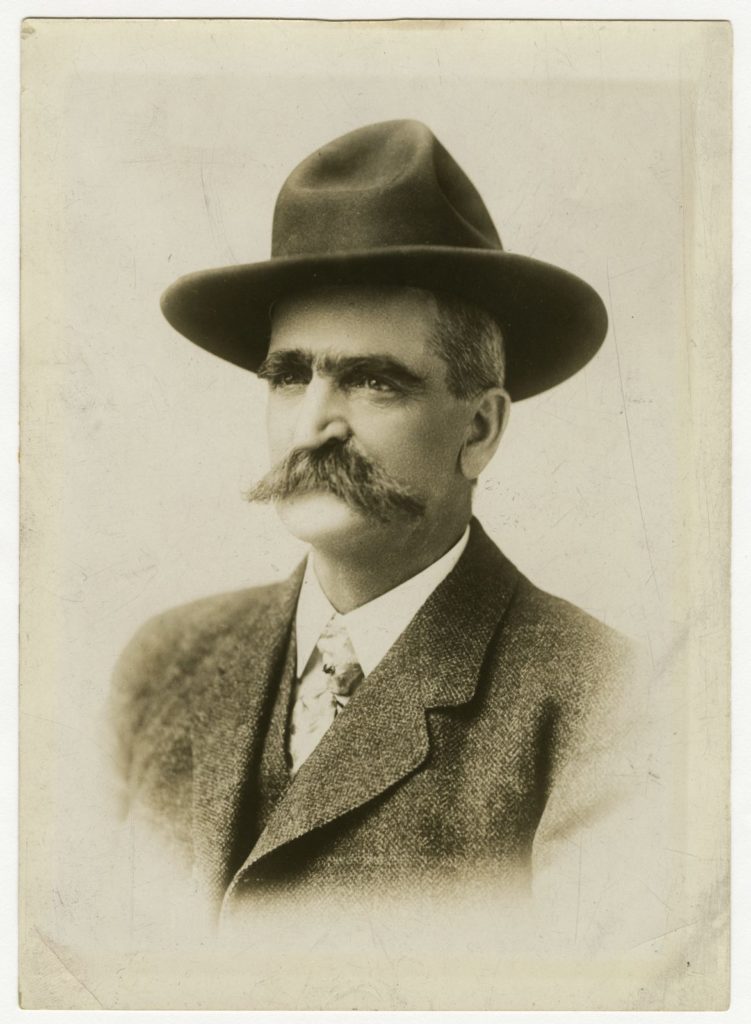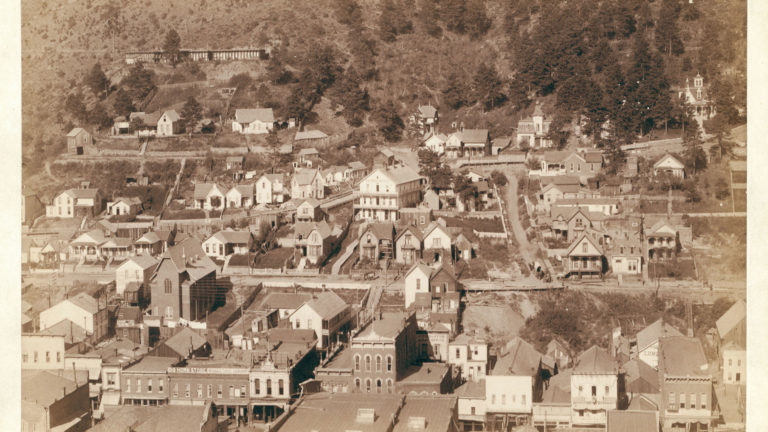As Deadwood became more civilized, (due in large part to Bullock’s authority), Seth devoted more of his time to raising thoroughbred horses and a family on the ranch he and Star established nearby at the confluence of the Belle Fourche and Redwater Rivers. Bullock planted alfalfa on his ranch in 1881, generally credited as being the introduction of this important crop to the state of South Dakota. Seth also participated in mining, politics, and other business ventures while continuing to serve as Deputy United States Marshal in Dakota Territory, and later for the state of South Dakota.
Bullock and Sol Star founded the town of Belle Fourche by persuading the Fremont, Elkhorn and Missouri Valley Railroad to build a line to the site of the former Bismarck to Deadwood Stage stop on the Bullock-Star Ranch in 1890. Bullock offered free lots for any building moved from the nearby town of Minnesela to his “new” town. Belle Fourche boomed as the county seat of Butte County, and quickly became the largest railhead for livestock shipping in the United States.
In 1895, Bullock oversaw the construction of the Bullock Hotel on the site of the hardware store in Deadwood, which had been destroyed by fire in 1894. The 64-room “Bullock” was a sought after luxury hotel of its time in the region, and boasted a bathroom on each floor.
In his “spare” time, Bullock helped to secure a Federal fish hatchery for the Black Hills area, located at Spearfish (today known as the D.C. Booth Historic Fish Hatchery).

Bullock was a close friend of another American icon—none other than Theodore Roosevelt. This personal friendship between the Bullock and Roosevelt families had begun years prior when the two men met as lawmen on the rangelands. Roosevelt wrote in his Autobiography:
“. . . I went down to Deadwood on business, Sylvane Ferris and I on horseback, while Bill Jones drove the wagon. At a little town, Spearfish, I think, after crossing the last eighty or ninety miles of gumbo prairie, we met Seth Bullock. We had had rather a rough trip, and had lain out for a fortnight, so I suppose we looked somewhat unkempt. Seth received us with rather distant courtesy at first, but unbent when he found out who we were, remarking, “You see, by your looks I thought you were some kind of a tin-horn gambling outfit, and that I might have to keep an eye on you!” He then inquired after the capture of “Steve”—with a little of the air of one sportsman when another has shot a quail that either might have claimed—”My bird, I believe?” Later Seth Bullock became, and has ever since remained, one of my staunchest and most valued friends. He served as Marshal for South Dakota under me as President. When, after the close of my term, I went to Africa, on getting back to Europe I cabled Seth Bullock to bring over Mrs. Bullock and meet me in London, which he did; by that time I felt that I just had to meet my own people, who spoke my neighborhood dialect . . .”
During the Spanish-American War, Bullock had volunteered for active service in the Cavalry and was named Captain of Troop A in the famous Rough Riders Cowboy Regiment.
Eventually Roosevelt, the newly elected Vice President under McKinley, appointed Bullock as the first Forest Supervisor of the Black Hills Reserve. Invited to Roosevelt’s presidential inaugural in 1905, Bullock startled citizens by recruiting 50 young cowboys, including Tom Mix, to ride their horses in the inaugural parade. The cowboys, in full garb and six shooters, reportedly made quite a spectacle as they rode down Pennsylvania Avenue. Roosevelt soon appointed Bullock as United States Marshal for South Dakota, a position he held for 9 years.
Roosevelt’s death on January 6, 1919, came as a personal blow to Bullock. By mid-February, however, he was working on a tribute to his good friend, enlisting the aid of the Society of Black Hills Pioneers to erect a monument to Roosevelt on Sheep Mountain near Deadwood. The peak was renamed Mount Roosevelt, and Bullock organized the construction of a tower made of native Black Hills stone at the summit. The tower was formally dedicated on July 4th, 1919.
Bullock passed away in room 211 of the Bullock Hotel in September of 1919, leaving a large historical legacy in the Black Hills region. He is buried on the high north side of Mount Moriah Cemetery in Deadwood, facing north toward Mount Roosevelt. It has been reported by many that Bullock’s ghost still wanders the hallways of his old hotel at 633 Main Street in Deadwood.
Teddy Roosevelt probably put it best: Seth Bullock was “a true westerner, the finest type of frontiersman.”
Look for Seth Bullock as one of the pivotal characters in the new HBO historical fiction series DEADWOOD.
Sources:
Lee, Bob: Fort Meade
The Black Hills Bullock Hotel and Casino
Adams Museum and House
Deadwood Historic Preservation Office

